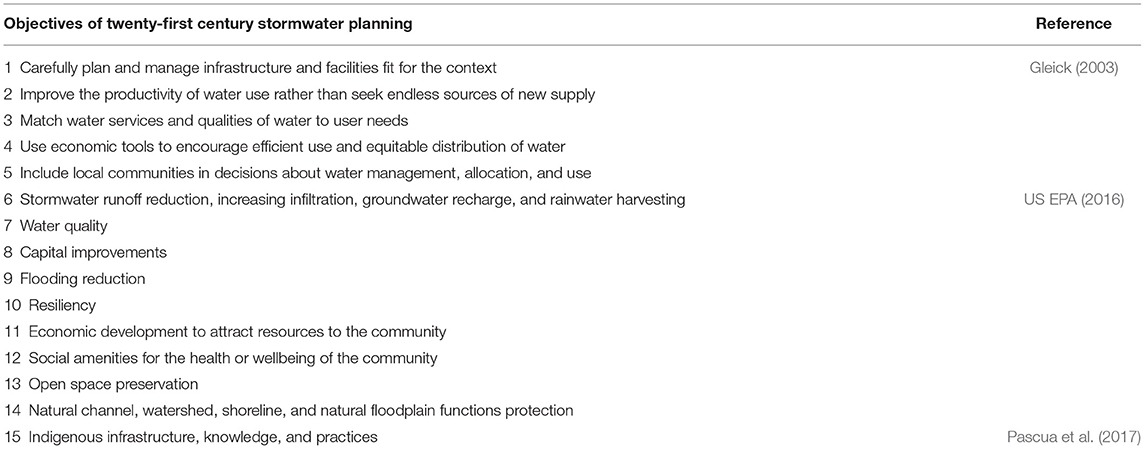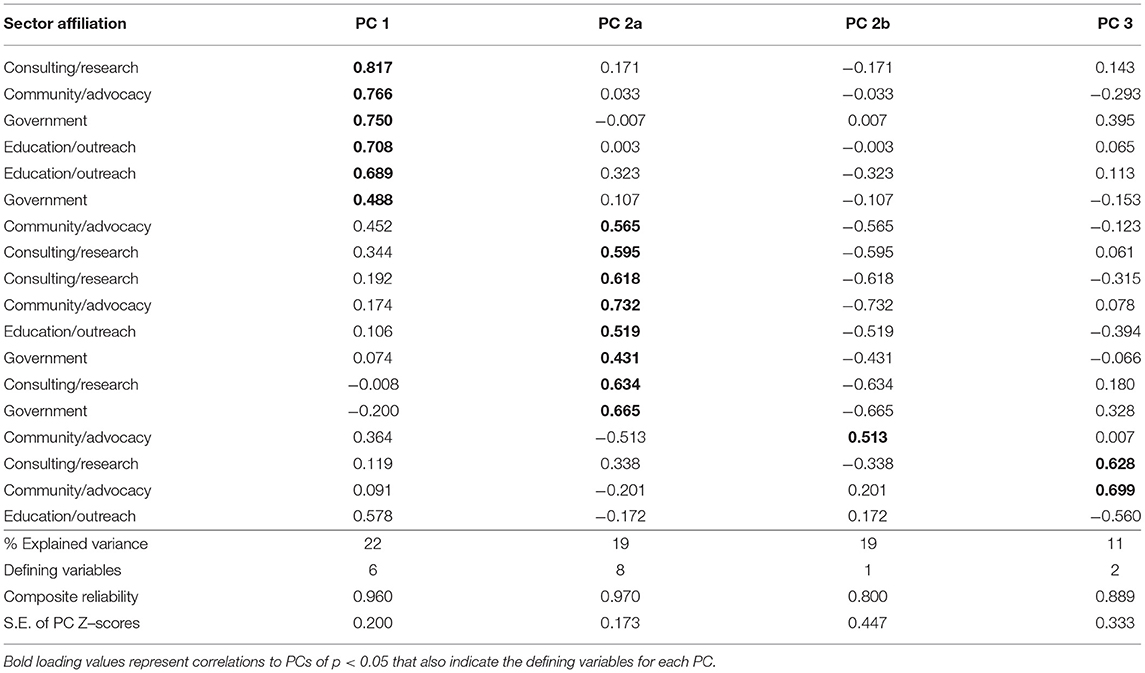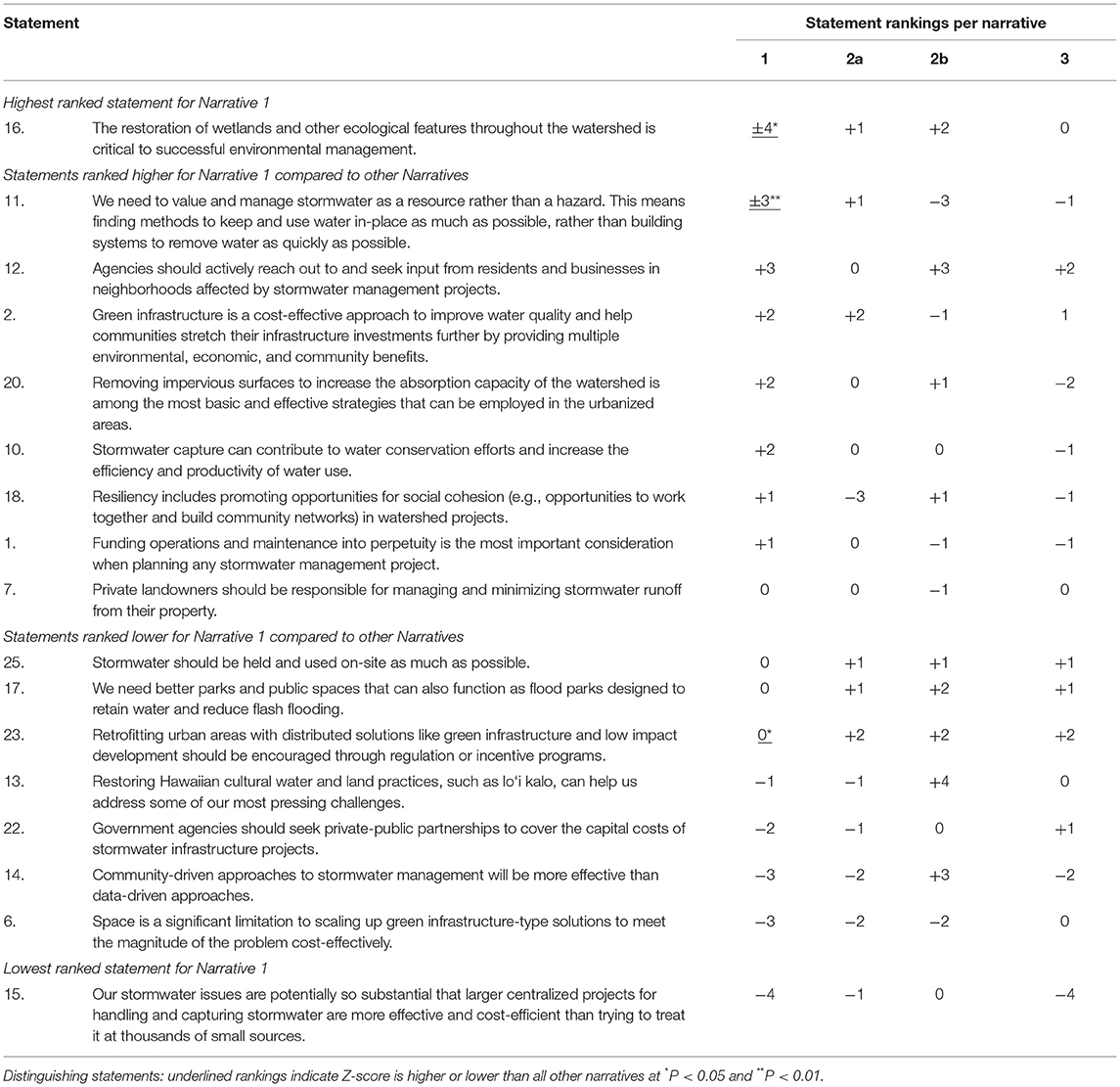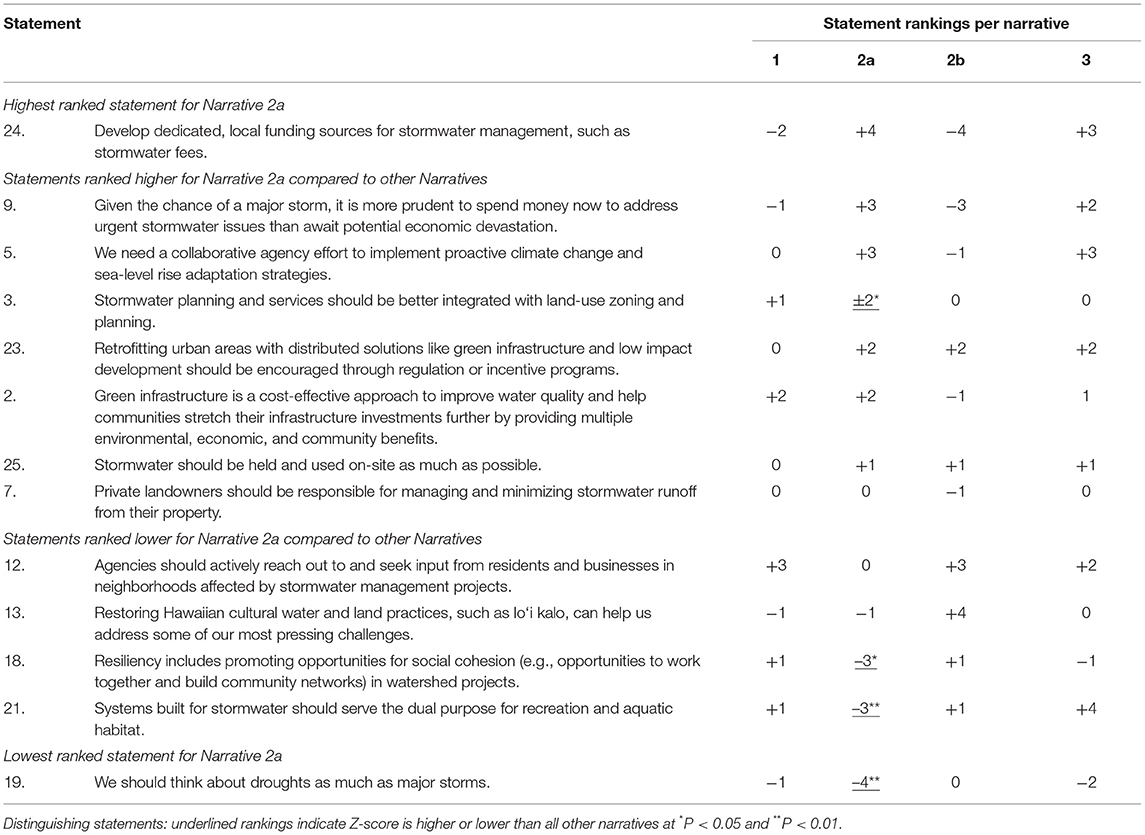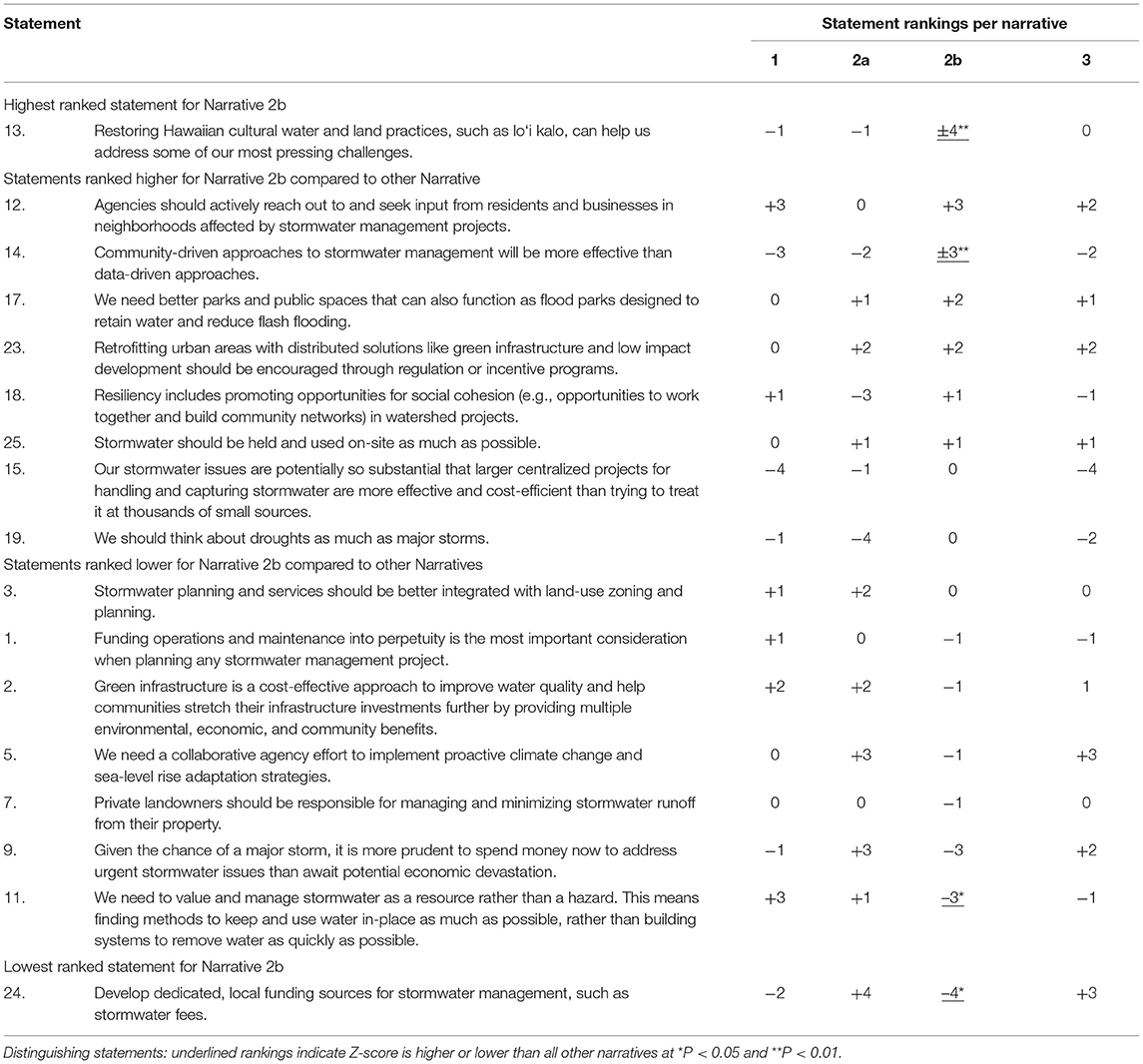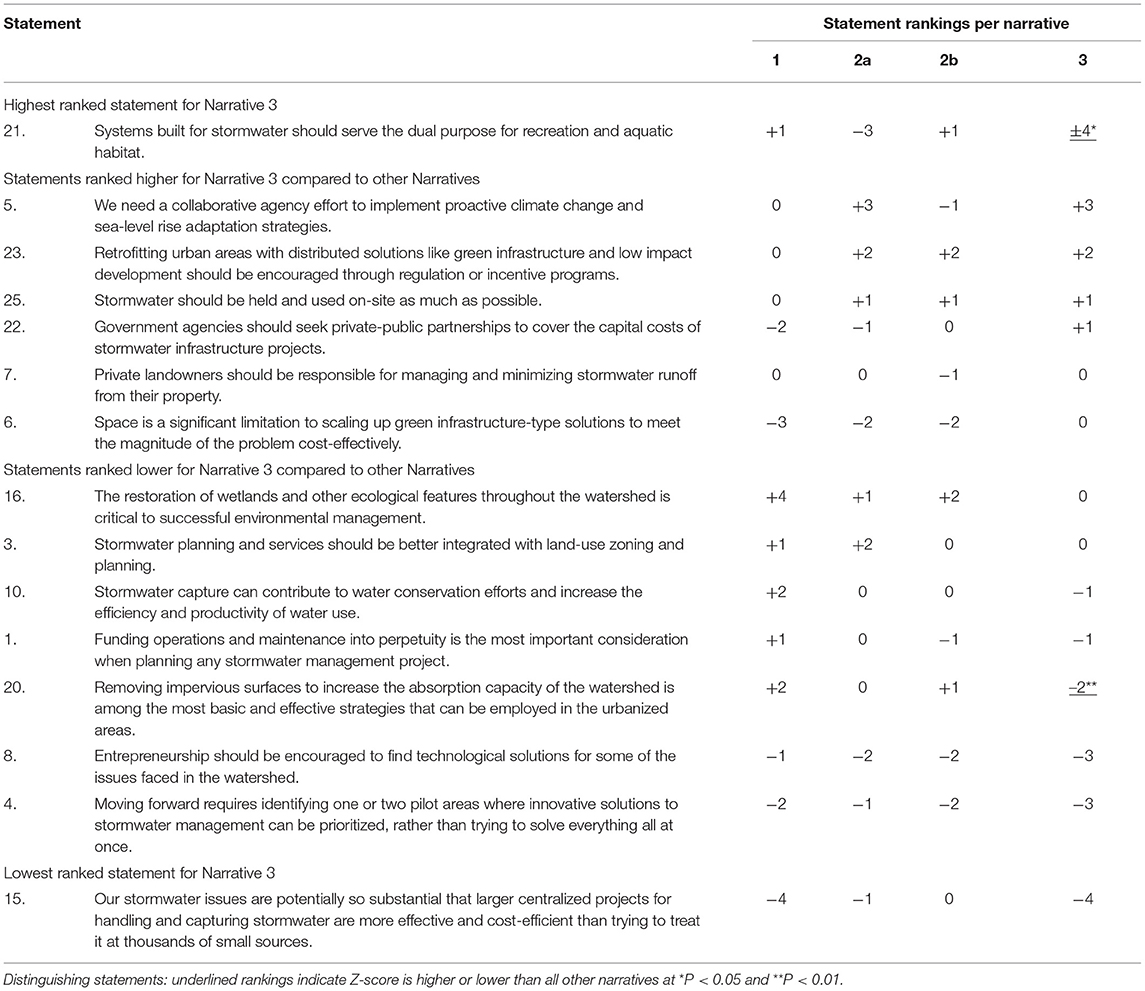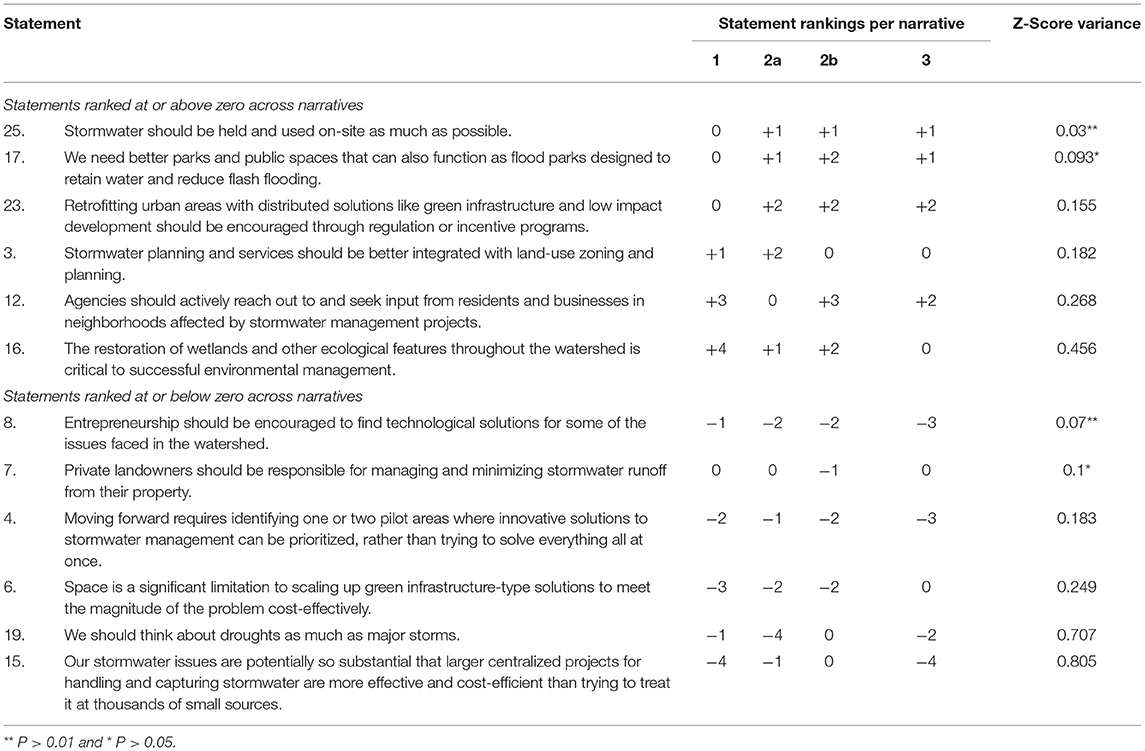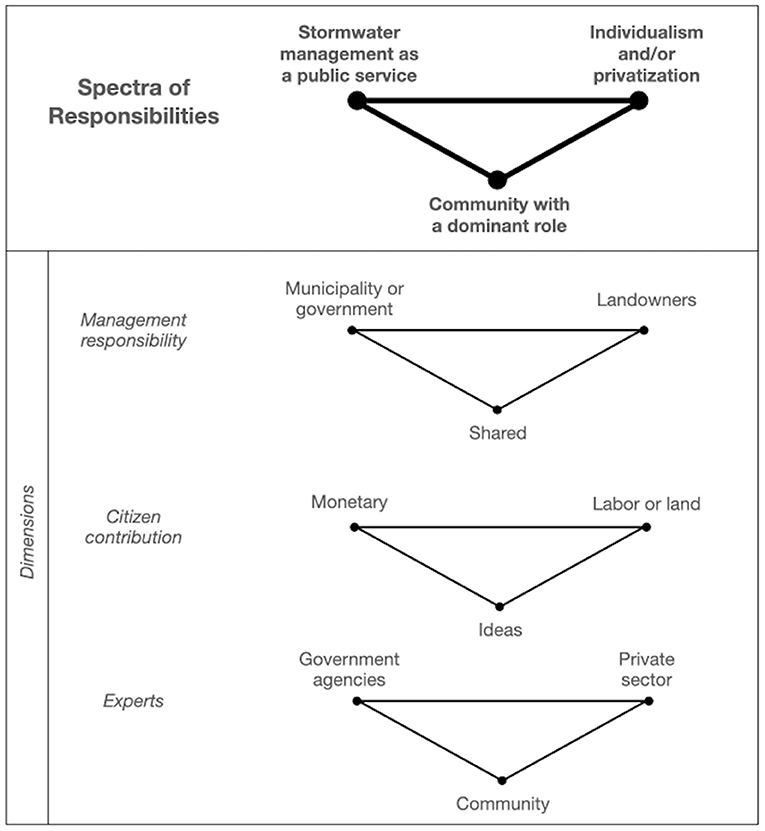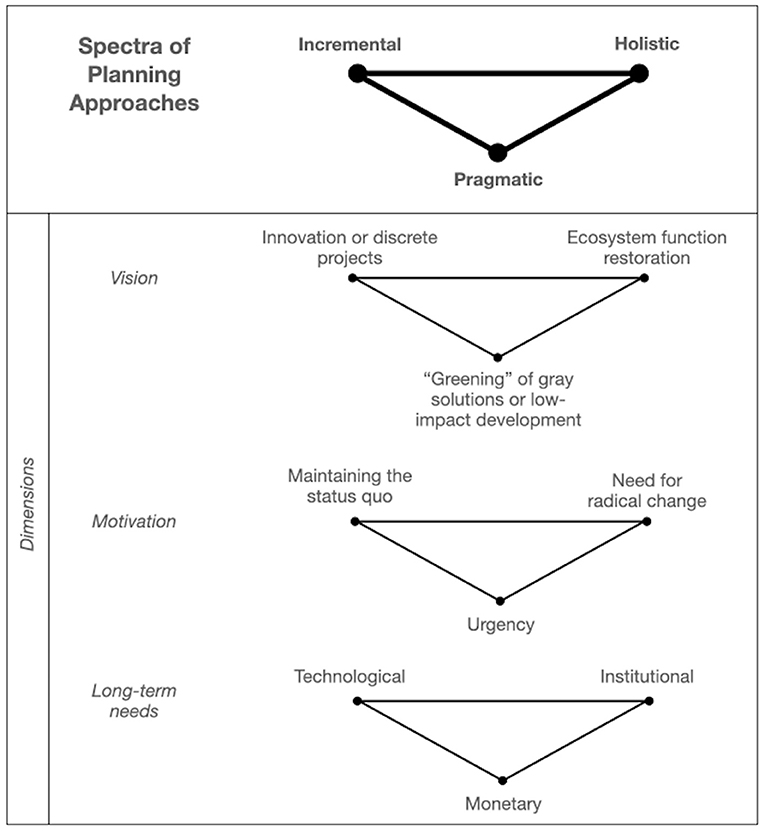- Department of Urban & Regional Planning, University of Hawai‘i at Mānoa, Honolulu, HI, United States
Stormwater management is a fundamental public service in urban areas that has wide-ranging implications on water supply, public safety, and ecosystem health. This paper examines stormwater management priorities expressed by community leaders and residents, educators, industry professionals, and water managers. It uses Q-methodology, a mixed-method approach, to understand prevalent narratives around stormwater management that comprise the public discourse. The purpose of this research is to elucidate points of agreement and disagreement in the context of a contentious flood risk management project. In total, 18 participants ranked an identical set of 25 idea statements relative to one another. Through principal component analysis, I identify four distinct narratives that prioritize different aspects of stormwater management objectives. The narrative analysis shows broad agreement that decentralized, soft infrastructure (e.g., green infrastructure) should be part of stormwater management solutions. However, there is widespread disagreement over funding mechanisms, the community's responsibilities, and the underlying planning approach to stormwater management. There was no discernable pattern in sector affiliation with any of the narratives. I summarize the dimensionality of stormwater governance and the potential spectrum of ideas about infrastructure, responsibilities, and planning approaches in a framework that characterizes competing viewpoints. The results of this study are useful in understanding underlying sources of conflict regarding stormwater management that may not be readily apparent in public discourse.
Introduction
Precipitation contributes to critical processes in the water cycle, including replenishing aquifers through infiltration, creating soil moisture, and generating flow to surface water bodies. Urban landscapes fundamentally alter these processes where the impervious nature of developed land leads to a reduction in infiltration, increased overland flow as stormwater, flashier runoff events, and dispersion of pollutants to natural bodies of water (Kondoh and Nishiyama, 2000; Henderson, 2002; McDonald et al., 2014; Güneralp et al., 2015). Stormwater management infrastructure and policies are a critical public service in urban governance, which has important implications for water supply, public health and safety, and ecosystem health as affected by both water quantity and quality (Porse, 2013; Hoekstra et al., 2018). Changes in rainfall patterns associated with climate change exacerbate risks of flooding or drought that exist through the hardening of watersheds (Hoegh-Guldberg et al., 2018; Prudencio and Null, 2018). Moreover, in coastal areas, sea-level rise can compound stormwater management issues where tidal inundation can prevent stormwater infrastructure from draining and cause drainage systems to backup (Spanger-Siegfried et al., 2014).
The legacy of water resources development and flood protection in the 20th century is the successful rise of cities in the US, often at the expense of natural processes that allow for infiltration of water into the ground, reduce the speed and peak of water flow, and provide biological and physical filtration of water (National Academies, 2016). Characteristic of water resources management during the 20th century is the fragmented management of various aspects of water and related sectors, top-down implementation of projects, expert-driven solutions that do not seek to incorporate stakeholder viewpoints, and little to no consideration of the consequences to the environment when meeting water demand (Lane, 2005; Innes and Booher, 2010; Mukheibir et al., 2014). These features extend to stormwater management—or flood control, in 20th century vernacular. Increasingly, current water management philosophies are shifting from the conventional top-down approach to promoting inclusivity of local communities in decision making and valuing water as one resource in its many forms (e.g., freshwater, stormwater, wastewater) (Gleick, 2003; Christian-Smith et al., 2012; Grant et al., 2012; US Water Alliance, 2017).
Stormwater governance includes a complex network of institutions and policies regulating, managing, planning, or advocating for stormwater management infrastructure and solutions. Jurisdiction over various stormwater management objectives is dispersed across many entities and is usually based on the locational occurrence of stormwater—first as rainfall, then as excess runoff. The cross-jurisdictional nature of stormwater presents many dimensions of potential management possibilities which create wicked problems that are often exacerbated by constraints created by historical systems and future concerns (Rittel and Webber, 1973; Innes and Booher, 2010). Wicked problems often involve competing and intractable tradeoffs with no easy solution. Without clear solutions, collaborative governance offers a means of seeking successful outcomes in wicked problems (Innes and Booher, 2010; Emerson et al., 2012). Healey (2009) defines collaborative governance as “any kind of practice centered on resolving collective action problems in the public sphere or realm.” Collaborative planning and the dialogue between governing institutions and policies and the community can foster trust, which is an essential component of successful governance (Tsai and Ghosal, 1998). Moreover, dialogue between community and resource management agencies is fundamental to determining desired outcomes. However, fostering this level of communication and coordination in stormwater management can be a particularly complicated endeavor where competing ideas about desired outcomes and potential solutions can lead to tension and conflict that stifles effective dialogue.
For this study, I focus on the perceptions of stormwater management in the Ala Wai watershed of Honolulu, Hawai‘i. Following the designation of federal funding for a US Army Corps of Engineers (USACE) Flood Risk Management project in July 2019, disagreements about the project led to an intense clash between community and government actors, upstream and downstream watershed residents and uses, as well as new vs. conventional approaches to stormwater management (Honore, 2018; Caron, 2019; Downey, 2019; Pursel, 2019; Schuler, 2019). A combination of the project proposing to exercise eminent domain and the seeming lack of transparency and public engagement in the project development galvanized residents of the watershed to rise in opposition (Honore, 2019a; Schaefers, 2019; Speakman, 2019). The uprising of the community in response to the USACE project is indicative of a reaction to an opaque, top-down process that tends to cultivate distrust (Forester, 1989; Huet, 2020). The motivation of this study is to understand whether ideas about stormwater management infrastructure, responsibilities, and planning approach converge or diverge between community members and water managers. This research uses a mixed-method approach, Q-methodology, to understand narratives that are present in the current discourse around stormwater management in the Ala Wai watershed. Specifically, the methodology uses a dimension reduction technique to understand the overlapping and diverging priorities between narratives. Establishing points of agreement and disagreement between narrative groups can be useful to understand the underlying core ideas about stormwater management that may not be apparent in the public discourse, in order to initiate dialogue and rebuild trust for future stormwater management endeavors. A critical component to the conflict motivating this research study is to understand the role of community in stormwater governance and whether views differ between the community and those in positions to drive management decisions.
Study Context
For this research, I chose the Ala Wai watershed as a case study because of a media attention-grabbing controversy between the community in the Ala Wai watershed and the U.S. Army Corps of Engineers (USACE). The Ala Wai watershed, situated in the Primary Urban Core of Honolulu, serves as a major economic engine for the State of Hawai‘i and is a highly-populated area (Fujii, 2016). Contained within the watershed is the world-renowned coastal tourist destination of Waikiki1, whose development primarily exists because of the Ala Wai Canal. The roughly 3-kilometer long artificial canal runs through an area that was historically wetlands and is less than half a kilometer's distance from the shoreline. Completed in 1928, the rationale for the Ala Wai canal was to “reclaim certain unsanitary lands,” for which the land values skyrocketed nearly 400 times in the period that the canal was being built and tourism to Waikiki doubled (Steele, 1992). In reality, the destruction of the wetlands through the dredge-and-fill practices used to build the Ala Wai Canal displaced and destroyed the livelihoods of many indigenous farmers who cultivated taro in the wetlands (lo‘i kalo). The story of the Ala Wai Canal and much of the land and coastal development of the surrounding areas reflects the imposition of colonial capitalism on Native Hawaiians and their land (Silva, 2004). Beginning with the destruction of the Waikiki fishponds (indigenous coastal structures used for subsistence fishing) in 1909 to build Fort DeRussy, the Ala Wai Canal cemented the current legacy of Waikiki as a tourist destination and the uprooting of the long indigenous history of the area (Connelly, 2020).
The original design of the Ala Wai Canal was to have two outlets to the coast. However, due to concerns about polluted, sediment-latent water ruining the attraction of the Waikiki beaches, the southern outlet was never completed (Cocke, 2013a). This unfortunate, incomplete design creates many further present-day issues. First, without a southern outlet for the flow of water, sediment build-up in the canal requires the canal to be dredged periodically. Waikiki was initially envisioned as single-family homes but is now occupied by high-rise condos and hotels, which is not what the infrastructure was originally built to accommodate (Honolulu Civil Beat, 2013). Consequently, during some high rainfall events, the wastewater system has been subject to overflow into the Ala Wai canal, creating dangerous water quality conditions and toxic sediment in the canal (Thompson, 2017). Along with poor ambient water quality, the canal's periodic dredging is well known to create toxic conditions detrimental to public health and aquatic wildlife (Glenn and McMurtry, 1995; Cocke, 2013b). Second, although the Ala Wai canal exists to drain a naturally-occurring wetland area, the Ala Wai canal cannot provide sufficient flood protection against a major storm event, which would likely devastate Waikiki (US ACE, 2017; Cocke, 2018). Flooding is a significant concern for the coastal neighborhood of Waikiki because much of the Ala Wai watershed upstream is hardened by impervious surfaces and the drainage infrastructure was not built to accommodate the amount of development existent today. Third, sea-level rise will likely exacerbate these issues in the Ala Wai Canal and the drainage infrastructure in the watershed if the status quo is held (Hawai'i Climate Change Mitigation Adaptation Commission, 2017).
Even with a checkered history and the public health dangers, the Ala Wai Canal is a recreational focal point for the resident community (Cocke, 2013c), just as it has become the focus of the USACE Flood Risk Management Study. The State Department of Land and Natural Resources (DLNR) is responsible for the dredging and improvements of the Ala Wai Canal. At the request of DLNR, the USACE completed a Flood Risk Assessment of the Ala Wai Canal in 2018, after more than a decade of effort (US ACE, 2017). The recommended project aims to address stormwater issues throughout the Ala Wai watershed, focusing on the Ala Wai Canal's flooding risk. Although the USACE claims the design process included public engagement, many residents of the community only became generally aware of the proposed projects in 2018 when the project's federal funding was secured through the US Congress. The funding mechanism requires a state partner to match funds, which further raised community awareness of the project when the State budgeted the $125 million matching funds to $345 million in federal funds in December 2018 (Yerton, 2018; Yoshioka, 2019). As knowledge of the project spread, it received strong resistance from many Ala Wai watershed community members culminating in a lawsuit over the misfiling of an Environmental Impact Statement (Honore, 2019a; Schaefers, 2019; Speakman, 2019). At the beginning of 2021, the USACE held several public meetings and adjusted the project recommendations to remove three of the originally-proposed upper watershed basins that were not well-received (Honore, 2019b). The project's price tag also nearly doubled to $651 million (Schaefers, 2021a).
Undoubtedly, there is a need to address stormwater issues in the Ala Wai Canal and throughout the Ala Wai watershed. However, sentiment over how stormwater should be managed ranges from wanting to see natural wetlands restored to moving forward with the USACE project (Caron, 2019; Civil Beat Editorial, Board, 2019). Regardless of what the solution set looks like, many community members felt that USACE should have consulted the public throughout their assessment process (Pursel, 2019; Speakman, 2019). Since the project lost its sponsorship from the federal government of $345 million in construction funding, the USACE is in the process of identifying a new flood risk management plan for the watershed (Schaefers, 2021b). There are a clear range of opinions over what stormwater management does and should look like both institutionally and infrastructurally (Huet, 2020). These ideas create a discourse in the news, social media, and public meetings that often portrays community against government. However, just as the issues are complex, viewpoints around stormwater management are multi-faceted and more nuanced than apparent or portrayed.
Methods
This study employs Q-methodology, which is a mixed-method research technique used to study participant viewpoints and offers a means to bring objectivity into subjective research (Stephenson, 1935, 1953). I selected Q-method for several reasons. First, the outcome of the Q-method is to identify multiple narratives by identifying patterns in participant priorities and reducing the total dimensionality of responses. Compared to survey instruments that often aim to find a prevailing narrative, Q-methodology does not require a representative sample size nor a random sampling of subjects (Robbins and Krueger, 2012; McKeown and Thomas, 2013; Zabala et al., 2018). This is because the data input for the analysis is the “Q-sort,” which is a sorted set of identical statements unique to each respondent, rather than an analysis of the respondents as a sample population. Second, a principal component analysis is a method to statistically distinguish narrative groups that may not be readily apparent with a purely qualitative methodology. The interpretation of the narrative groups found through statistical analysis is aided by information gathered through semi-structured interviews. Finally, the Q-method is useful for understanding divisive environmental management problems (Addams, 2000; Webler et al., 2009; Sy et al., 2018). The same methodology is used for stormwater management studies conducted in Chicago and Los Angeles (Cousins, 2017a,b,c). The Cousins studies employ the same concourse of statements in each study, and interviews are conducted solely with water managers. The focus of the research questions in those studies is in regards to understanding opinions of how stormwater should be governed. One major difference from the Cousins studies is that I include community members as participants in this study.
The conflict motivating this research study can be characterized by many tensions, including upstream vs. downstream, residents vs. tourists, or legacy infrastructure vs. desired infrastructure. Though there may be several potential dimensions to the conflict, a critical component to this research study is to understand the roles and views of community members and those in positions to drive stormwater management decisions. The use of Q-methodology enables the analysis of people's subjective ideas about how stormwater should be managed to understand the main narratives that exist as part of the discourse.
I summarize the steps to systematically conducting a Q-method study in three major actions in the sections below, including the process of statement collection, interviews, and data analysis (Addams, 2000; Webler et al., 2009; Watts and Stenner, 2012; McKeown and Thomas, 2013). Figure 1 summarizes how to conduct a Q-methodological study and the sub-steps employed for each main action.
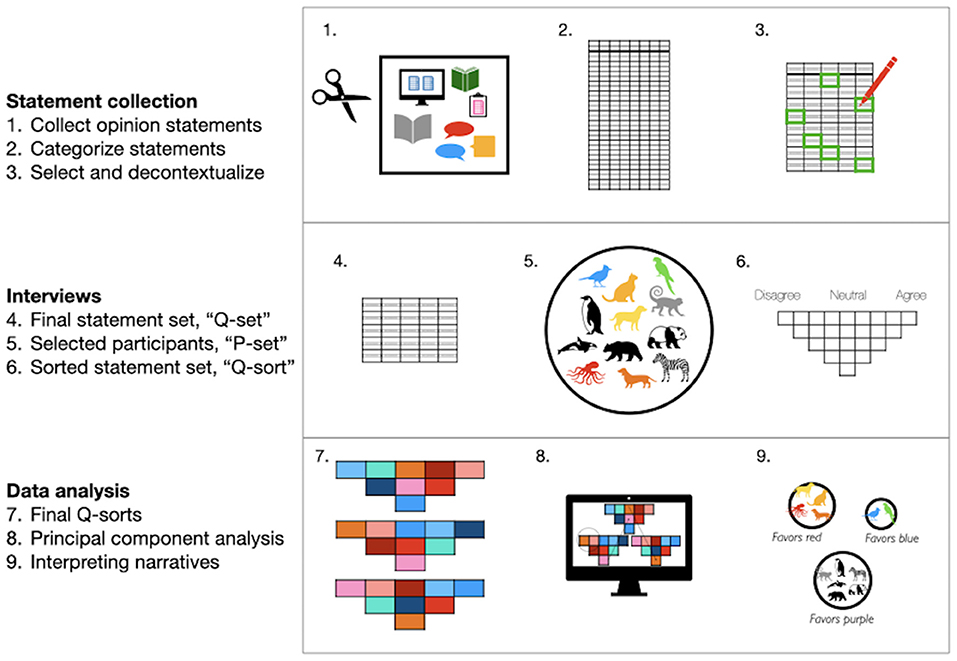
Figure 1. Nine steps in Q-methodology include the creation of a statement set, interviews, and data analysis to interpret the narratives. This graphic was used to explain the process to the interviewees.
Statement Collection
The concourse of statements, or the “Q-set,” is a selection of opinion statements that are not readily provable (Webler et al., 2009). The statements are meant to be reacted to in relation to one another and interpreted differently by different participants. At the same time, each statement is intended to be a stand-alone idea that can be interpreted independently. To gather statements for this step, I conducted a thorough search of local news media sources and article comments, media videos and comments, and social media sources to gather sentiments related to water in the Ala Wai watershed. Although some online spaces tend to garner deconstructive and critical commentary, I only selected statements that added potentially constructive ideas to the dialogue. The statements were primarily collected in June and July 2019, reflecting a period during which local news outlets extensively covered the USACE project. To add more range of ideas into the set of statements, I searched through websites of local organizations working on various aspects of stormwater, either in the Ala Wai specifically, in the city or state, or more broadly. Additionally, I searched statements collected during previous semi-structured interviews (Chun et al., 2017) and took note of ideas expressed during public forums or other communications with key individuals. Finally, I pulled relevant statements used for two Q-method studies specific to stormwater management (Cousins, 2017a,b). This task aims to reach a point of saturation such that no new ideas are emerging in statements (Corbin and Strauss, 2008). In total, I collected 160 statements from 34 sources representing a spread of sectors.
Each statement was categorized according to the primary outcome expressed. To capture the complexity of various aspects of stormwater management, I used a categorization system shown in Table 1. The first five objectives come from Gleick (2003) to situate best practices for stormwater management in the concept of moving away from “hard” to “soft path” solutions. Objectives 6 through 14 are from the US Environmental Protection Agency (EPA) guidelines for voluntary long-term stormwater planning (US EPA, 2016). Finally, the last objective is inspired by Pascua et al. (2017) to incorporate indigenous relationships with the ecosystem that are often suppressed under colonial management systems. From an indigenous Hawaiian perspective, these include cultural ecosystem services such as Ike (Knowledge), Mana (Spiritual Landscapes), Pilina Kanaka (Social Interactions), and Ola Mau (Physical and Mental Wellbeing). Some aspects of stormwater management can be multi-objective. I used best judgment to assess the main objective of any given statement and also tagged secondary benefits. I had between 5 and 25 associated idea statements for each category.
I took several steps to finalize the set of statements used in this analysis. First, I selected the most compelling and clear statements in each of the 15 categories representing various perspectives. I edited some statements to decontextualize them so they would not be readily attributable to the source or connected to the USACE project. The purpose of this step was to ensure that none of the statements would conjure emotional reactions unrelated to the content of the statement and that the ideas could be applied to other watersheds. I also edited statements for clarity and greater specificity. My goal was to make sure that anyone with a non-expert working knowledge of stormwater issues could readily understand each statement. Although the statements are meant to be interpreted differently by different participants (Webler et al., 2009), I avoided ideas with too much room for misinterpretation. For example, a statement such as “stormwater capture and groundwater recharge has great potential” is too vague for this exercise because it offers no specifics about how these objectives could be achieved and does not offer much room for disagreement. I conducted two pilot rounds of interviews to reduce 41 statements to a final set of 25 (i.e., the “Q-set”). This helped eliminate confusing statements such as “infrastructural project outcomes should also include civic programming,” where the concept of “civic programming” was not commonly understood terminology. However, a collective understanding was not always desirable in statements. For example, I included several statements about “green infrastructure” that indirectly allowed the participant to demonstrate how they define or feel about the concept. I chose statements that portray different benefits of green infrastructure for which the participant can react and prioritize to self-define the concept. Notably, I opted for a smaller statement set since the statement sorting exercise and interviews were conducted virtually due to COVID-19 public health restrictions. Q-method studies average about 40 statements, ranging from 15–65 statements, but are commonly tactile exercises conducted in person (Lundberg et al., 2020).
Interviews and Statement Sorting Research Design
I conducted 18 semi-structured interviews over 3 months in late 2020. For efficacy in the narrative analysis, the total number of participants should be no greater than the number of statements and no less than half (Watts and Stenner, 2005). Participants were selected through purposive sampling with names found through the initial step of gathering statements or first-hand knowledge of key people involved in stormwater management and community organization. Although the selection of participants through purposive sampling can introduce researcher bias, this is a critical step to ensuring the quality of data collected for analysis will enable theoretically-sound interpretation (Dairon et al., 2017). Occasionally, further participants were identified through referral. The participants (i.e., the “P-set”) represent various entities involved in stormwater management or issues surrounding the Ala Wai watershed. The selection of participants was also based on evenly representing sector affiliations. There were four participants from government positions, five from consulting or research roles, five from community or advocacy groups, and four representing organizations dedicated to outreach or education. In inviting each person to participate in this study, I identified their role or position related to the Ala Wai watershed. Each participant was willing to respond from the position specified, even though some participants identified multiple roles that might affect their responses. I assigned each participant to one of the four sector affiliations post-interview and followed up with participants with the opportunity to provide feedback. Although I did not explicitly collect demographic data, I interviewed a set of participants representing a diverse range in gender, age, race, geographic relation to the watershed, and career backgrounds.
All interviews were conducted virtually via videoconference due to public health concerns imposed by the COVID-19 pandemic. For the statement sorting exercise, I used the Q-Method Testing and Inquiry Platform (Q-TIP)2 provided by the University of Wisconsin-Madison Geography Department. Each participant was asked to arrange the 25 statements according to the ranking arrangement shown in Table 2, referred to as the “Q-sort.” The Q-sort creates a forced prioritization of statements relative to one another, with the greatest number of statements prescribed to a neutral ranking (i.e., neither agree nor disagree). The statement order was randomized. However, the Q-TIP platform did not allow for the initial step recommended by Q-methodologists of sorting the statements into three piles of “agree,” “neutral, and “disagree.” Instead, the participants immediately sorted the statements into the Q-sort arrangement and were encouraged to re-arrange statements throughout the sorting exercise. The sorting exercise was followed by a semi-structured interview to understand the rationale for statement rankings (Block, 2008). Although the research study was designed to understand the core of how community members and water managers believe stormwater should be managed in the Ala Wai watershed outside of the contentious environment surrounding the USACE project, the participants were nonetheless asked to rank the statements based on their ideas and experiences in the Ala Wai watershed and asked follow-up questions during the interview to better understand whether and how they have been involved with the USACE Ala Wai Flood Risk Management Project.

Table 2. The research design for sorting 25 statements relative to one another, from most disagreeable (−4) to most agreeable (+4), with neutral in the middle (0).
Narrative Analysis
Q-method employs data reduction techniques to determine a small set of narratives from the prioritized statement sets of each participant (i.e., Q-sorts) collected during the interview process. To use a dimensionality reduction technique, each Q-sort represents a variable, where similarities or differences can be identified between variables. Essentially, the analysis process takes the 18 Q-sorts and reduces them to 2 to 5 narrative groups, or “average” Q-sorts (Webler et al., 2009). I used the Ken-Q Data open-source code3 to conduct the narrative analysis. I use Principal Component Analysis (PCA) along with the “varimax rotation” technique to ensure principal components have meaning and are interpretable (Akhtar-Danesh, 2017); this is explained further below. The combination of PCA and the varimax rotation offers a mathematically unique solution (Ramlo, 2016). The principal components determined through the mathematical procedures are then interpreted into narratives using the semi-structured interviews. Even with a mathematically unique solution, there are multiple ways to approach the narrative analysis. Therefore, Watts and Stenner (2012) recommend approaching the narrative analysis with clear analytical aims, where the results are not necessarily “expected” but should be “suspected” based on researcher knowledge gained through the interview process. In other words, it is possible to have a mathematically optimal procedure that does not optimally capture the underlying participant perspectives. Therefore, researcher knowledge provides a critical analytical check during the narrative analysis process.
Principal Component Analysis
Principal Component Analysis (PCA) is a linear transformation method used to reduce the dimensionality of a dataset by maximizing the variance (i.e., capturing the most amount of information) in the first principal component and minimizing the variance in the last principal component. There will be as many principal components as dimensions in the data. However, the objective of PCA is to prioritize the principal components by the amount of information they retain. As a general rule, principal components with eigenvalues less than one can be eliminated since correlation values of the input matrix will be no greater than one (Watts and Stenner, 2005).
The resultant transformation of the data will yield correlation values of the variables (i.e., Q-sorts) to each of the principal components. However, in its raw form, the correlation values are an expression of a subspace where most variables correlate highly to the first principal component with many non-zero weights on subsequent principal components that make it difficult to interpret. Therefore, rotation methods are used to capture more meaning from the data and for ease of interpretation (Akhtar-Danesh, 2017). Orthogonal rotation techniques are commonly used in Q-methodology because it retains the assumption of independence between principal components (Addams, 2000). Varimax is an orthogonal rotation technique that maximizes the individual variable variance and minimizes the shared variance between principal components. That is, varimax aligns the transformed coordinate system so that any given variable correlates highly with one principal component and near-zero with the other principal components to the extent that the data will allow. The result is a more discrete representation of how the variables correlate to each principal component without losing the original data structure. Each defining variable (e.g., in this study, determined at p < 0.05) of a principal component will provide a weighted value based on its correlation to the principal component that will be used to calculate the “average” Q-sort for that principal component. The “average” Q-sorts are reconstructed based on the Z-score values of the 25 statements (i.e., the statement with the highest Z-score value is assigned +4 ranking, and the lowest Z-score is assigned−4 ranking). The Z-scores also allow for comparisons of statements between the narratives. The statistics gathered from the mathematical procedures enable the analytical process to interpret the narratives derived from the principal components.
Post-analysis Interpretation
Interpreting the meaning of the narratives based on the PCA results is a critical final step to connect the subjectivity of the interviewees to the data collected. The semi-structured interviews are used to ensure the mathematical results of the PCA align with the ideas that were expressed by participants. An essential piece of this step is finalizing the number of principal components (PCs). For example, having more PCs means there are more narratives and potential more nuance between the different narratives. On the other hand, having fewer PCs means fewer narratives and potentially greater contrast between narratives. To decide on the number of PCs requires alignment between the participants that correlate with the PCs using the information gathered during the semi-structured interviews. With the preliminary results, I contacted the participants as an opportunity for them to provide any further feedback based on the narratives that I interpreted from the analysis.
Results
Participant Loadings on Components
In total, I analyzed 18 Q-sorts (i.e., the prioritized statement sets of each participant) for this narrative analysis. Three principal components that explained 51% of the variance with eigenvalues greater than one were included in the analysis. I explored the results of retaining 2–6 principal components, and decided to retain three for interpretation based on how well they aligned with interview conversations. Of the 18 participants, 17 loaded on (i.e., correlated to) the three principal components with p < 0.05, as shown in Table 3. Component 2 was considered a bipolar component and split into two effectively opposite narratives (i.e., components 2a & 2b). Component 1 has six defining variables (i.e., participant Q-sorts) and four distinguishing statements (p < 0.05) with a composite reliability (i.e., a measure of the internal consistency of the principal component) of 0.96 and a standard error of component Z-scores of 0.20. Component 2a has eight defining variables and five distinguishing statements with a composite reliability of 0.97 and a standard error of component Z-scores of 0.17. Component 2b has one defining variable and four distinguishing statements with a composite reliability of 0.80 and a standard error of component Z-scores of 0.45. Component 3 has two defining variables and three distinguishing statements with a composite reliability of 0.89 and a standard error of component Z-scores of 0.33. There are four consensus statements between all principal components that do not distinguish between any pair of components (p > 0.01). There was no strong alignment between affiliations of participants and loading on components.
Narrative Interpretations of Principal Components
PC 1: Stormwater Solutions Are Strongly Connected to Land Use and Stewardship
This is a narrative that centers around the tension between centralized and decentralized project solutions, where it tends to prioritize decentralized solutions and de-prioritize centralized projects. The narrative is characterized by a strong connection between land use and land stewardship as critical to both the creation of current issues in the watershed and key factors to stormwater management solutions. Ideas prioritized in this narrative relate to restoring natural features, valuing and managing stormwater as a resource rather than a hazard, and green infrastructure. Ideas that were de-emphasized in this narrative include space as a limitation to green infrastructure and the centralization of stormwater management projects. Table 4 summarizes the notably ranked statements for this narrative compared to other narratives.
Participants who correlated to this principal component favor decentralized solutions and emphasize the need for a holistic, watershed-level approach to stormwater management. One participant, in particular, pointed to statements 16 (“The restoration of wetlands and other ecological features throughout the watershed is critical to successful environmental management.”; p < 0.05, d*), 11 (“We need to value and manage stormwater as a resource rather than a hazard. This means finding methods to keep and use water in-place as much as possible, rather than building systems to remove water as quickly as possible.”; p < 0.01, d**), and 13 (“Restoring Hawaiian cultural water and land practices, such as lo‘i kalo4, can help us address some of our most pressing challenges.”) as interchangeable concepts. Statement 13, however, ranked relatively low for this narrative because of the general feeling among other participants that land ownership and urbanization is too large of an obstacle for implementing Hawaiian land and water management practices in the Ala Wai watershed specifically. Emphasizing decentralized solutions, another participant offered the thought experiment dividing $200 million (approximating the then-cost of the USACE Project) amongst landowners to build rain gardens and hold rainwater on their property. There was a general sense that spending money on stormwater management would be fruitless unless through collaboration between the community and government.
This narrative's lowest ranking statements represent a rejection of reasons often used against green infrastructure, ecological restoration, and decentralized solutions. In particular, one younger participant attributed statements 15 (“Our stormwater issues are potentially so substantial that larger centralized projects for handling and capturing stormwater are more effective and cost-efficient than trying to treat it at thousands of small sources.)” and 6 (“Space is a significant limitation to scaling up green infrastructure-type solutions to meet the magnitude of the problem cost-effectively.”) as outmoded, rejecting them as “old school thinking” that is the cause of many of the problems currently faced in the watershed. Seemingly counterintuitive to this narrative's emphasis on decentralized solutions, statement 23 (“Retrofitting urban areas with distributed solutions like green infrastructure and low impact development should be encouraged through regulation or incentive programs.” p < 0.05, d*) ranked low. One participant de-prioritized statement 23 with the rationale that stormwater management should be done for the intrinsic value of the ecosystem and not through incentives or regulation. Another participant was skeptical that regulation would motivate private landowners to implement best practices if not already doing so. At the same time, another suggested that blanket implementation of regulation or incentives would lead to uneven benefits where some watershed areas are better suited for stormwater runoff management than others. There was also general cynicism around the private industry's role in stormwater management, reasoned with skepticism over whether private investment ventures would truly operate in the public's best interest rather than a company's bottom line.
PC 2a: Stormwater Management Is an Essential Government Service
This narrative (and its inverse, PC2b) captures the tension between the responsibility of the government and the role of the community. This narrative is characterized by the desire for prioritizing funding and moving forward with the implementation of stormwater management projects, though not necessarily the USACE project. A summary of notable statements is provided in Table 5. Many of the ideas prioritized in this narrative emphasize distributed green infrastructure solutions alongside prioritizing the need for funding sources and a collaborative government agency effort for climate change adaptation strategies. Because the Ala Wai watershed receives ample rainfall, the suggestion to consider droughts as much as major storms was generally de-prioritized as a “common sense practice” rather than a priority issue. Participants who correlated to this component tended to emphasize the role of stormwater management as a public service that the government offers and prioritized other ideas around that central notion. This includes rethinking land use zoning policies to better integrate stormwater management and finding ways to minimize stormwater runoff in current spaces. Many of the participants comprising this narrative who did not hold a government position at the time of the interview either worked closely with the government in their role or worked in a government position in the past.
Although not clearly reflected in this narrative's statement ranking, many of the participants who correlated to this component expressed the importance of building trust between the community and government. Several participants referenced the USACE project as providing a strong lesson in the need for community involvement in stormwater planning and management. They suggested that stormwater management in Honolulu should evolve accordingly. Often, participants referenced periphery benefits of implementing distributed solutions to foster trust between government and community when projects are successful and visible. Some of these projects have a clear way of bringing in the community as an actor. For example, one participant referenced “depaving parties” as an idea that can be adopted in the Ala Wai watershed, where community organizations can spearhead prioritization efforts to remove impervious surfaces in highly visible public spaces as a way to be involved in stormwater management. Such projects can demonstrate the government's commitment to action. However, in this framework of government having a central role, this narrative stops short of suggesting that stormwater management projects should promote social cohesion opportunities, such as projects that include a recreational component.
Similar to narrative 1, this narrative de-prioritizes statement 13 regarding restoring indigenous cultural practices based on the sentiment that the Ala Wai watershed is too urbanized to address the “most pressing challenges” of stormwater management. There was a considerable variation in the prioritization of this statement among participants and between components because of the various interpretations spanning from literal to philosophical. Across the board, no participant fundamentally disagreed with the concept of the statement. However, those who ranked this statement lower tended to feel that the statement was too strongly worded and interpreted the statement literally. One participant who ranked the statement highly referenced indigenous infrastructure as “the original public works.”
PC 2b: Stormwater Management by and for the Community
Principal component 2b is the practical inverse of 2a, meaning this narrative prioritizes many of the ideas that component 2a de-prioritizes and vice versa. Table 6 shows a summary of notable statements for narrative 2b. This narrative centers stormwater management around the community, acknowledging that it is a public service provided by the government that should be community-driven. While most participants in this study took issue with the wording of statement 14, wanting instead to see community- and data-driven approaches working hand-in-hand, this narrative prioritizes the concept. The participant who correlated with this narrative prioritized the statement with the rationale that the community can help direct and prioritize what data are critical to understanding the needed approaches. This narrative also prioritizes distributed and soft infrastructure solutions, similar to narrative 1, and generally considers social issues equal to natural systems restoration. For example, the concern over statement 24 (“Develop dedicated, local funding sources for stormwater management, such as stormwater fees.”) stems from the high cost of living in Honolulu and concern for funding being spent on hard, centralized infrastructure (i.e., business as usual). This narrative bears some similarities to narrative 1 in that these narratives envision a self-sustaining system if stormwater is managed correctly. Although it is typically better for analysis for more than one variable to correlate to a principal component, it is not a requirement (Watts and Stenner, 2005). It may be a limitation of the purposive sampling that I was not able to interview more participants who might correlate to this narrative.
PC 3: Stormwater Management as a Collaborative Effort
This narrative tends to capture a pragmatic approach that characterizes stormwater management as an issue that requires collaboration, community contribution, and financing. Similar to all others, this narrative prioritizes soft, decentralized infrastructure ideas. However, unlike narratives 1 and 2b, these participants convey the need for capital financing of projects through private-public partnerships. Similar to component 2a, this narrative believes that private landowners should pay into stormwater management as a public service. However, opposite component 2a, this narrative prioritizes statement 21 (“Systems built for stormwater should serve the dual purpose for recreation and aquatic habitat.”) as a means to bring attention to stormwater issues and create community buy-in on projects. The participants who correlate to this component emphasized the need for approaching stormwater management holistically but tended to view each idea in the context of local politics. Thus, these participants prioritized based on weighing politics alongside their perception of the stormwater management needs. For example, one participant felt that funding operations and maintenance should ideally not impede moving forward, but acknowledged that this is a real obstacle to implementing City projects. Table 7 summarizes the notable statement rankings for this narrative.
The Consensus-Disagreement Spectrum
In this analysis, I found four consensus statements—statements 25, 8, 17, and 7—where the principal component Z-scores are not significantly distinguishable between any pair of components. This means that rankings were similar amongst all narrative groups. The consensus statements include a general agreement that stormwater should be held and used on-site as much as possible, that entrepreneurship should not be prioritized to find technological solutions, that parks and public spaces should be designed to retain water and reduce flash flooding, and neutrality (i.e., neither prioritized nor de-prioritized) over whether private landowners are responsible for minimizing stormwater runoff from their property. On the other end of the spectrum, rankings are highly variable between narrative groups around developing dedicated funding sources for stormwater management such as stormwater fees, moving forward to spend money now rather than facing potential economic devastation from a major storm, and managing stormwater as a resource rather than a hazard. In particular, statements 11 and 24 regarding developing dedicated funding sources for stormwater management and valuing stormwater as a resource rather than a hazard, respectively, are statistically distinct in two or more narratives (P < 0.05).
Table 8 shows select statements by Z-score variance in ascending order to show the spectrum of consensus to disagreement among statements. Statements consistently prioritized at or above a zero ranking (i.e., neutral) among all narratives are shown to demonstrate ideas that narrative groups support. Statements consistently de-prioritized at or below a zero ranking are also shown. Prioritized statements tend to show a desire to incorporate stormwater management and distribute green infrastructure in current spaces through better integration of stormwater management into built and natural land features. The nature of the ideas emphasizes the government's role in providing stormwater management as a public service alongside prioritizing agencies actively reaching out to seek input from affected residents and businesses. De-prioritized statements tend to show the opposite. Ideas that are de-prioritized include privatizing the role of stormwater management, approaching the solution incrementally, and centralized solutions.
Discussion
Comparing Across Narratives
This study shows a coalescence around several ideas related to stormwater management. First, there is strong agreement over the need for green infrastructure-type solutions, showing a movement away from hard infrastructure characteristic of the 20th century toward softer solutions to stormwater management. Along similar lines, there is broad agreement that stormwater management solutions need to be distributed rather than centralized. Narratives also tended to promote infrastructure ideas that offer secondary natural systems benefits, such as water quality improvement or increased infiltration. There was less tendency toward agreement on infrastructure that directly provides civic benefits, such as recreational options and opportunities to create social cohesion. Narratives tended to suggest better use of space for stormwater management, such as in parks or through better integration of stormwater planning with land-use zoning. Overall, there was a general affirmation of stormwater management as a public service provided by the government.
Views around stormwater management diverge around responsibilities, funding, and underlying planning approaches. In particular, there was a wide extent of opinions regarding what citizens contribute, whether monetary, labor, or ideas. Generally, individual labor contribution (e.g., being responsible for runoff from one's property) was not a high priority. However, there was a split in narratives over whether citizen contribution should be in the form of paying into services or contributing ideas to the management process. No narratives suggested that the private sector should have a role in stormwater management. Participants tended to have a strong negative reaction to the word “entrepreneurship,” suggesting that they did not see a role for profit-driven enterprises in stormwater management. The phrase “private-public partnerships” tended to conjure similar reactions. One participant suggested that there were too many bad examples of private-public partnerships. Along similar lines, there was no strong hope for technological solutions or innovation to solve stormwater problems. Narratives tended to focus on either retrofitting the current system or restoring ecosystem functions. Fundamental views over long-term planning needs also varied significantly. There was no strong agreement over whether long-term needs are infrastructural, institutional, or monetary in nature. The USACE project shaped many participants' views on this front. For example, one participant expressed the perception that there is money for stormwater management, just not for the right types of projects. Overall, no strong pattern was revealed regarding affiliation, which were mixed between all narratives.
Characterizing Competing Views on Stormwater Governance
Stormwater management and planning are inherently multi-dimensional, and adding to the dimensionality are the various views of how stormwater should be governed. Here, I summarize the spectrum of viewpoints around various aspects of stormwater governance in a framework to show the dimensionality of the choice set that are often discussed in the literature and that participants in this study were grappling with during interviews. These include competing ideas that regarding how stormwater should be managed in terms of stormwater infrastructure, responsibilities, and planning approaches.
Stormwater Infrastructure Approach
Concepts predominantly associated with gray infrastructure vs. green infrastructure are often viewed as opposing. Figure 2 describes the spectrum of choices in approaching stormwater infrastructure solutions. Gray infrastructure—also “hard” infrastructure—is frequently associated with engineered solutions that control the environment (e.g., canals to drain the land and convey water, basins to retain water). These solutions tend to be (or are perceived to be) large, centralized, and require sizable capital investments (Finewood, 2016). Gray infrastructure is often the common practice and can also be embedded in land use laws and proliferated through private development (Rosenbloom, 2018). Because of the singular purpose of such infrastructure and the static nature of such projects once completed, cost-benefit analyses are generally straightforward to conduct to motivate budgeting (Krieger and Grubert, 2021). At the same time, gray infrastructure implementation may result in adverse consequences requiring mitigation that are not included in standard cost-benefit analyses, such as water quality mitigation (Allerhand et al., 2009). On the other hand, various ecologically-oriented engineering tactics such as green infrastructure and natural functions restoration focus on reducing runoff while retaining the water's benefits as a resource. Green infrastructure—also “soft” infrastructure—usually includes multiple objectives and focuses on creating positive ancillary outcomes (e.g., civic space, water quality improvement). Green infrastructure is frequently associated with engineered solutions that restore or mimic natural functions and may include distributed solutions such as low-impact development, but is often more difficult (or is perceived to be) difficult to evaluate the cost-effectiveness (Flynn and Davidson, 2016). Because green infrastructure tends to require greater upkeep and maintenance, it is often associated with greater labor demand (Dhakal and Chevalier, 2017). The dimensions for gray and green infrastructure are generalizations and may change depending on the context of a project.
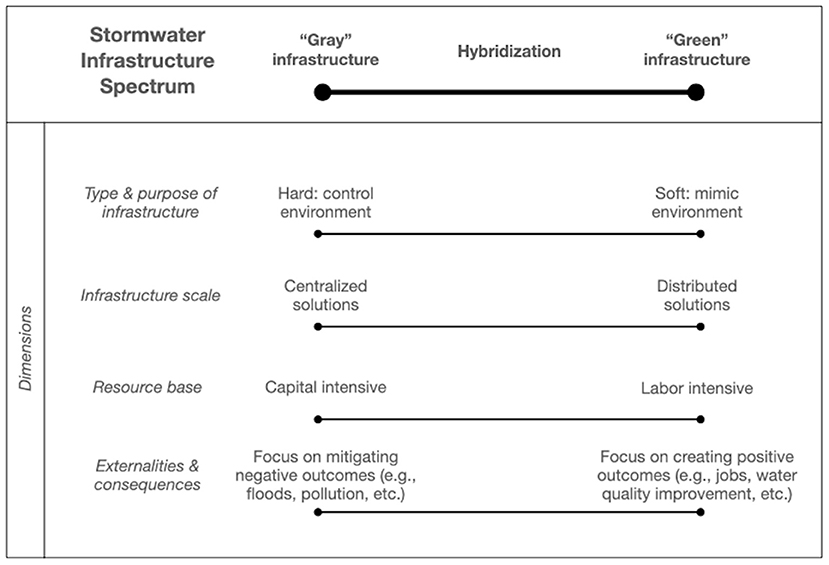
Figure 2. A framework to understand the spectrum of choices to approach stormwater infrastructure. Most current infrastructure projects might fall in the middle. Adapted from Porse (2013).
In major cities built based on 20th-century flood control principles, the legacy is often that of hard infrastructure, on which cities must retrofit new solutions. Therefore, achieving redefined outcomes for stormwater management built on legacy systems might include a wide array of often competing ideas to reconcile the concept of a new design with the constraints of an old system. Transitioning away from infrastructure built for the sole purpose of flood protection to adaptive, multi-functional infrastructure is a long-term, multistep process. As Porse (2013) describes, realistic constraints on the natural and built environments tend to force actual implementation options toward the middle or some hybrid combination of options. As is detailed in the planning approach framework below, I associate this hybridization of infrastructure with a pragmatic approach to stormwater planning. Table 9 includes notable quotes from interviews grappling with concepts around green vs. gray infrastructure. In this study, I found a tendency in narratives to favor distributed, soft solutions that achieve positive outcomes but a lack of strong opinions around resource base. Municipalities faced with budgetary uncertainties for operations and maintenance may be perceived as being against green infrastructure even if supportive of other dimensions of the green infrastructure approach. Therefore, a common understanding of responsibilities for stormwater management is a critical foundation to deciding infrastructure approaches.
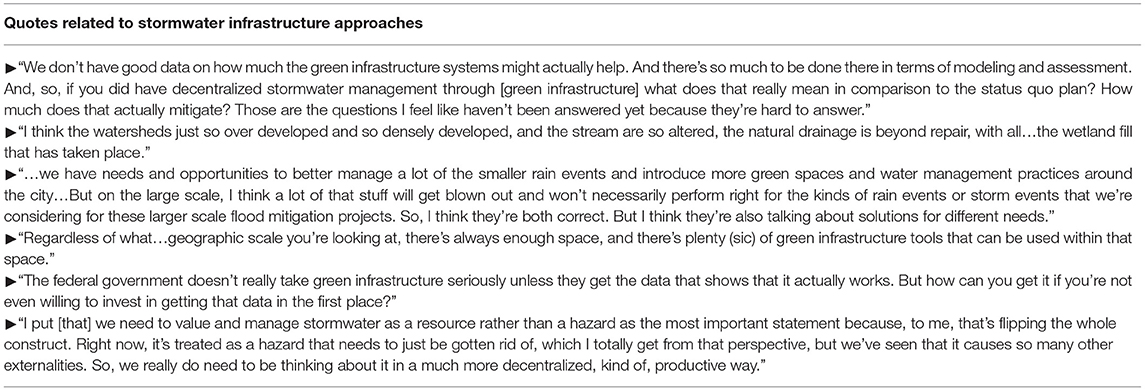
Table 9. Notable quotes from study participants regarding their ideas about various aspects of stormwater infrastructure.
Responsibilities
Jurisdictional purview may be clearly defined for some aspects of stormwater management, but not all (Brown, 2005). For example, water quality parameters in natural water bodies are regulated by the Clean Water Act, and therefore discharges from public stormwater conveyance systems require permitting that can be costly to manage (Allerhand et al., 2009). On the other hand, non-point source pollution (e.g., landscaping chemicals or oils and heavy metals from cars) and total runoff are more challenging to manage because of the dispersed land jurisdictions from which runoff comes. Figure 3 illustrates the various spectra of responsibilities over stormwater management. Managing stormwater can be considered the role of government, the role of individual landowners where rain falls, or some combination of both (Arora et al., 2015). Because stormwater management is a public service, it necessitates some degree of citizen contribution, which may be monetary, labor, or ideas (Lake, 1996; Syme et al., 2002; Keeley, 2007). Defining expert roles and the functions of various expertise for stormwater management is also critical to understanding responsibilities over stormwater management. Conflict may arise over differing views of responsibilities, especially where those roles are not clearly defined. Table 10 includes quotes from interviews regarding ideas around roles and responsibilities over stormwater management. This study showed that most narratives consider stormwater management to be strongly within the government's responsibility and mixed thoughts about the role of individuals and the community in stormwater management. In general, there was no strong agreement over what citizens contribute to the process, but there was strong agreement that the private sector should have a minimal role.
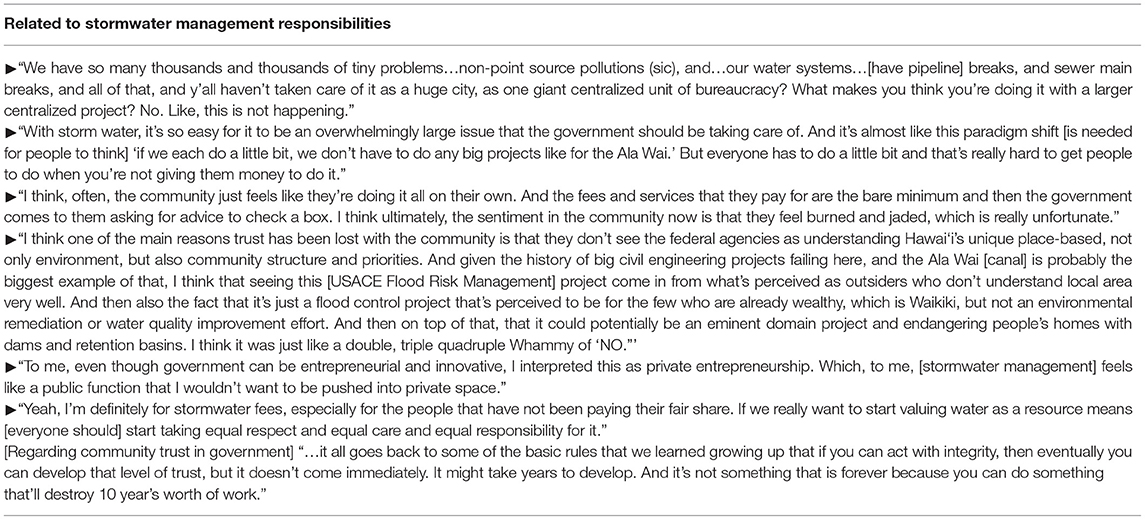
Table 10. Notable quotes from study participants regarding their ideas about roles and responsibilities over stormwater management.
Planning Approach
Dialogue necessarily includes ideas that come from differing approaches to stormwater management planning (Montanari et al., 2015). These may include fundamentally different visions, motivations, and ideas about long-term needs. Planning viewpoints are often unspoken, although they may bubble to the surface indirectly in conversations around infrastructure. Figure 4 shows a range of approaches to planning. A pragmatic approach to implementation is often the practical default for projects because of the realities of timelines and budgets. Pragmatism here represents a pull toward a middle-of-the-road approach that is often motivated by urgency. Urgency may come out of some form of necessity (e.g., a shock) or perception of need (e.g., chronic stressor). As Finewood (2016) discusses, just as there is a “greening” of gray infrastructure, there can be a loss in the democratic process of stormwater management through this middle-of-the-road approach. Therefore, urgency can take away from radical needed change such as moving toward environmental justice or from a holistic vision of ecosystem function restoration. Innovation or technical solutions can be considered the contrast of ecosystem function restoration. Because technological solutions can rarely address sweeping problems with stormwater, they contribute to an incremental planning approach. For example, to avoid more difficult discussions and larger capital investments, installing pump stations to deal with nuisance flooding from sea-level rise is an incremental solution using technology to maintain the status quo. The viewpoints in this study tended to stay away from innovation and technology as solutions but were wide-ranging around other aspects of vision and motivation.
Views of long-term needs may also change people's foundational planning approach to stormwater management. This may be a perception that either infrastructure, institutions, financing or some combination of the three need planning attention. If planning needs are infrastructural, then the built environment would be the focus of a planning effort (Kessler, 2011; Lim and Welty, 2018). Institutional planning efforts may include measures to enact policies or regulations around stormwater (Cettner et al., 2013; Kvamsås, 2021). Monetary needs would shift the focus of planning efforts toward seeking mechanisms for financing (Kea et al., 2016; Stormwater Infrastructure Finance Task Force, 2020). These concepts are not mutually exclusive and can work in tandem. For example, policies can create funding sources, or regulations can lead to infrastructure changes. Notable quotes from participants discussing these concepts are included in Table 11. In this study, there was a spread of viewpoints around the long-term needs, and participants tended to acknowledge the interlinkages between long-term needs. This framework represents generalities, and viewpoints may map differently in other contexts.
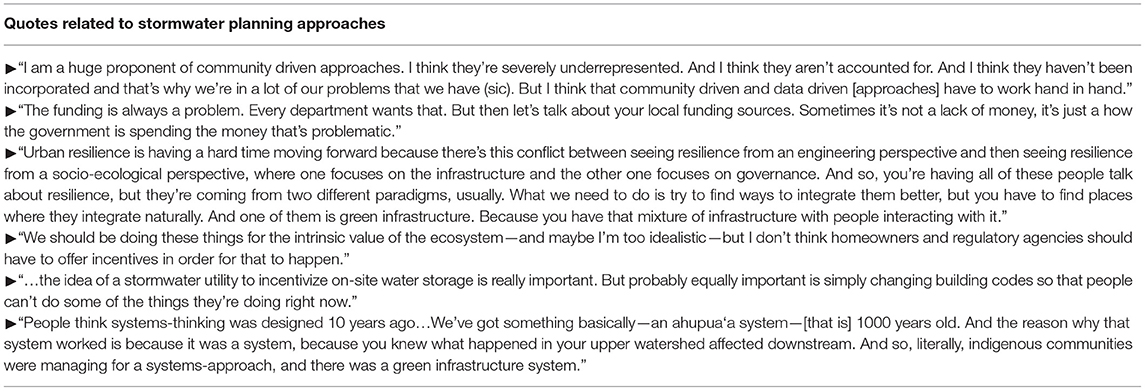
Table 11. Notable quotes from study participants regarding their ideas about stormwater planning approaches.
Conclusion
Dialogue is a fundamental means of shaping desired outcomes in planning. Coming to a common or acceptable understanding of “desired outcomes” can be challenging when a wide range of viewpoints exists around an inherently multi-dimensional problem. This study uses Q-methodology to elucidate specific narratives within the broader discourse about stormwater management in relation to a contentious USACE Flood Risk Management Study. The uprising of the community in response to the opaque, top-down process used by the USACE Study is indicative of the cultivation of distrust. When trust between the government and community is lost, it is both difficult to regain and conduct good-faith dialogue to find desired outcomes, even if a project has merit. Q-methodology is a means to understand individual priorities by asking participants to rank various ideas according to a structure that forces few ideas to be prioritized and de-prioritized. The outcome of the Q-method is to interpret the narratives that comprise the public discourse. Through the narrative analysis, specific points of agreement and disagreement can be used to initiate discussion and start rebuilding trust through dialogue.
This study finds four narratives that describe differing priorities for stormwater management. The first narrative (PC 1) describes a strong connection between land stewardship and stormwater solutions. There is a clear emphasis on restoration of natural function and green infrastructure in the first narrative, paired with a strong rejection of centralized solutions. This narrative also prioritized community involvement in decision-making as part of holistic water management, with the belief expressed by participants that successful holistic, natural functions restoration and community involvement will be a self-sustaining solution that costs less in the long run. The second and third narratives are effectively opposite and might represent narratives that dominate the news and social media. The second narrative (PC 2a) affirms stormwater management as an essential government service and prioritizes financing mechanisms and integrated management. This narrative also emphasizes the urgency of taking action while de-emphasizing the need to explicitly incorporate civic benefits into project solutions. In contrast, the third narrative (PC 2b) focuses on the role of the community in stormwater management as a major priority. Finally, the fourth narrative (PC 3) emphasizes collaborative aspects of stormwater management, including inter-agency collaboration and collaboration between community and government.
Although the issues surrounding the USACE Flood Risk Assessment of the Ala Wai Canal can easily be perceived as polarized (e.g., community vs. government, upstream vs. downstream, residents vs. tourists) through news reports and social media, this analysis shows there is much greater nuance in the discourse. Most participants expressed that there were very few or no statements to which they were fundamentally opposed. All four narratives tend to agree that there should be more distributed soft infrastructure solutions that provide secondary water management benefits. Community engagement in projects often revolves around infrastructure solutions. However, narratives tend to diverge around responsibilities, funding, and underlying planning approaches rather than specific infrastructure solutions. In other words, visions of infrastructure outcomes are not as disparate as they may appear in public forums, but rather underlying differences in the “how-to” of infrastructure implementation lead to points of contention even if they are not part of the conversation. These differences suggest that more discussion around responsibilities and planning approaches could alleviate misunderstandings often misattributed to infrastructural solutions. Notably, there was no discernable pattern in the participants' affiliations and the correlations to narratives, suggesting an optimistic outlook for dialogue through the proper engagement of the community in stormwater management.
This work demonstrates a clear need for communication between the community and decision-makers to find desired outcomes in stormwater management. Often community engagement components of project planning processes involve one-way communication, either to inform the community about a project or gather information from the community. To build trust and converge on a common understanding of stormwater management needs, communication should be a two-way collaborative learning process. For example, in the case of financing, this study, found no clear consensus from where resources should come. On the one hand, there is a broad understanding of stormwater management as a public service for which resources are necessary. However, mistrust in government to effectively provide stormwater management services often drives taxpayers to reject opportunities to support financing and budgeting for stormwater services. The competition of ideas in this case study regarding stormwater infrastructure, stormwater management roles and responsibilities, and stormwater planning approaches echo sentiments found in other municipalities where communities are increasingly vested in stormwater management outcomes.
Data Availability Statement
The raw data supporting the conclusions of this article will be made available by the authors, without undue reservation.
Ethics Statement
The studies involving human participants were reviewed and approved by University of Hawai‘i Human Studies Program. The patients/participants provided their written informed consent to participate in this study.
Author Contributions
AA confirms sole responsibility for the study conception and design, data collection, analysis and interpretation of results, and manuscript preparation.
Conflict of Interest
The author declares that the research was conducted in the absence of any commercial or financial relationships that could be construed as a potential conflict of interest.
Publisher's Note
All claims expressed in this article are solely those of the authors and do not necessarily represent those of their affiliated organizations, or those of the publisher, the editors and the reviewers. Any product that may be evaluated in this article, or claim that may be made by its manufacturer, is not guaranteed or endorsed by the publisher.
Acknowledgments
I would like to thank Dr. M. Coffman for guidance on this research, as well as Drs. K. Burnett, P. Das, S. Shen, and P. Garboden for advice, C. Reynolds for feedback, and the manuscript reviewers for their comments. I would also like to thank those who participated as interviews in this research. The fees for open-access publishing of this manuscript were provided by the University of Hawai'i Economic Research Organization.
Footnotes
1. ^Throughout this paper, I refer to “Waikiki” as it is used colloquially to refer to the coastal neighborhood bordered by the Ala Wai Canal. However, the system of land identification and management used by Hawaiians before 1848 considered Waikiki to be the entire ridge-to-coast land unit, or ahupua‘a, which I refer to as the “Ala Wai watershed” in this paper.
2. ^https://qtip.geography.wisc.edu/#/
3. ^https://shawnbanasick.github.io/ken-q-analysis/index.html
4. ^Lo‘i kalo is an indigenous wetland taro farming and terracing practice.
References
Addams, H. (2000). Q Methodology. In: Addams, H., Proops, J. (Eds.), Social Discourse and Environmental Policy: An Application of Q Methodology. Edward Elgar.
Akhtar-Danesh, N. (2017). Rejoinder: an overview of the statistical techniques in Q-methodology. Operant Subj. 38, 46–49. doi: 10.15133/j.os.2016.012
Allerhand, J. E., Boyer, K. B., Mccarthy, J., and Kieser, M. S. (2009). The cost of managing stormwater. J. Green Build. 7, 80–92. doi: 10.3992/jgb.7.3.80
Arora, M., Malano, H., Davidson, B., Nelson, R., and George, B. (2015). Interactions between centralized and decentralized water systems in urban context: a review. WIREs Water. 2, 623–634. doi: 10.1002/wat2.1099
Block, J. (2008). The Q-Sort in Character Appraisal: Encoding Subjective Impressions of Persons Quantitatively. American Psychological Association, Washington, DC. doi: 10.1037/11748-000
Brown, R. R. (2005). Impediments to integrated urban stormwater management: the need for institutional reform. Environ. Manage. 36, 455–468. doi: 10.1007/s00267-004-0217-4
Cettner, A., Ashley, R., Viklander, M., and Nilsson, K. (2013). Stormwater management and urban planning: lessons from 40 years of innovation. J. Environ. Plan. Manag. 56, 786–801. doi: 10.1080/09640568.2012.706216
Christian-Smith, J., Gleick, P. H., Cooley, H., Allen, L., Vanderwarker, A., and Berry, K. A. (2012). Introduction: The Soft Path for Water. In: Christian-Smith, J., Gleick, P.H., Cooley, H., Allen, L., Vanderwarker, A., Berry, K.A. (Eds.), A Twenty-First Century U.S. Water Policy. Oxford University Press. doi: 10.1093/acprof:osobl/9780199859443.001.0001
Chun, G., Adler, P. S., Arik, A. D., Burnett, K., Redding, N., and Wada, C. A. (2017). Organizational Study of Water Management Networks and Processes in Hawai‘i. Honolulu.
Civil Beat Editorial Board,. (2019). Don't Let Petty Politics Block A Project To Prevent Ala Wai Canal Flooding. Honolulu Civ. Beat.
Cocke, S. (2013c). Ala Wai Canal: If It Makes You Sick Why Not Shut Down Public Access? Honolulu Civ. Beat.
Connelly, S. (2020). Our city as ahupua‘a: for justice-advancing futures. In: Goodyear-Ka‘opua, N., Howes, C., Osorio, J.K.K., Yamashiro, A. (Eds.), The Value of Hawai‘i 3: Hulihia, the Turning. doi: 10.1515/9780824889159-058
Corbin, J., and Strauss, A. (2008). Theoretical Sampling. In: Basics of Qualitative Research. p. 143–157.
Cousins, J. J. (2017a). Of floods and droughts: the uneven politics of stormwater in Los Angeles. Polit. Geogr. 60, 34–46. doi: 10.1016/j.polgeo.2017.04.002
Cousins, J. J. (2017b). Infrastructure and institutions: stakeholder perspectives of stormwater governance in Chicago. Cities. 66, 44–52. doi: 10.1016/j.cities.2017.03.005
Cousins, J. J. (2017c). Structuring hydrosocial relations in urban water governance. Ann. Am. Assoc. Geogr. 107, 1144–1161. doi: 10.1080/24694452.2017.1293501
Dairon, M., Clare, S.R, and Parkins, J. (2017). Participant engagement and data reliability with internet-based q methodology: a cautionary tale. Operant Subj. 39, 46–59. doi: 10.15133/j.os.2017.011
Dhakal, K. P., and Chevalier, L. R. (2017). Managing urban stormwater for urban sustainability: barriers and policy solutions for green infrastructure application. J. Environ. Manage. 203, 171–181. doi: 10.1016/j.jenvman.2017.07.065
Downey, K. (2019). Neighborhoods Are Really Angry At The Feds' $345 Million Ala Wai Project Seven local boards want legislators to halt the flood. Honolulu Civ. Beat.
Emerson, K., Nabatchi, T., and Balogh, S. (2012). An integrative framework for collaborative governance. J. Public Adm. Res. Theory. 22, 1–29. doi: 10.1093/jopart/mur011
Finewood, M. H. (2016). Green infrastructure, grey epistemologies, and the urban political ecology of pittsburgh's water governance. Antipode. 48, 1000–1021. doi: 10.1111/anti.12238
Flynn, C. D., and Davidson, C. I. (2016). Adapting the social-ecological system framework for urban stormwater management: the case of green infrastructure adoption. Ecol. Soc. 21. doi: 10.5751/ES-08756-210419
Gleick, P. H. (2003). Global freshwater resources: soft path solutions for the 21st century. Science. 302, 1524–1528. doi: 10.1126/science.1089967
Glenn, C. R., and McMurtry, G. M. (1995). Scientific studies and history of the Ala Wai Canal, an artificial tropical estuary in Honolulu. Pacific Sci. 49, 307–318.
Grant, S. B., Saphores, J. D., Feldman, D. L., Hamilton, A. J., Fletcher, T. D., Cook, P. L. M., et al. (2012). Taking the “waste” out of “wastewater” for human water security and ecosystem sustainability. Science. 337, 681–686. doi: 10.1126/science.1216852
Güneralp, B., Güneralp, I., and Liu, Y. (2015). Changing global patterns of urban exposure to flood and drought hazards. Glob. Environ. Chang. 31, 217–225. doi: 10.1016/j.gloenvcha.2015.01.002
Hawai'i Climate Change Mitigation Adaptation Commission, (2017). Hawai'i Sea Level Rise Vulnerability and Adaptation Report.
Healey, P. (2009). The pragmatic tradition in planning thought. J. Plan. Educ. Res. 28, 277–292. doi: 10.1177/0739456X08325175
Henderson, V. (2002). Urbanization in developing countries. World Bank Obs. 17, 1, 89–112. doi: 10.1093/wbro/17.1.89
Hoegh-Guldberg, O., Jacob, D., Taylor, M., Bindi, M., Brown, S., Camilloni, I., et al. (2018). “Impacts of 1.5oC global warming on natural and human systems”, in Global Warming of 1.5°C. An IPCC Special Report on the Impacts of Global Warming of 1.5°C Above Pre-Industrial Levels and Related Global Greenhouse Gas Emission Pathways, in the Context of Strengthening the Global Response to the Threat of Climate Change, Sustainable Development, and Efforts to Eradicate Poverty, eds V. Masson-Delmotte, P. Zhai, H. -O. Poörtner, D. Roberts, J. Skea, P. R. Shukla, A. Pirani, W. Moufouma-Okia, C. Péan, R. Pidcock, S. Connors, J. B. R. Matthews, Y. Chen, X. Zhou, M. I. Gomis, E. Lonnoy, T. Maycock, M. Tignor, and T. Waterfield. [In Press].
Hoekstra, A. Y., Buurman, J., and van Ginkel, K. C. H. (2018). Urban water security: a review. Environ. Res. Lett. 13, 1–14. doi: 10.1088/1748-9326/aaba52
Honore, M. (2018). How The Ala Wai Canal Puts Honolulu's Most Valuable Real Estate At. Honolulu Civ. Beat.
Honore, M. (2019b). Army Corps Looks To Scrap Three Basins From Ala Wai Flood Plans. Honolulu Civ. Beat.
Huet, V. G. (2020). Infrastructure Projects and Climate Change Adaptation in the Era of Grassroots Movement Resurgence: Suggestions for Transformational Actions. Royal Institute of Technology (Kungliga Tekniska Högskolan).
Innes, J. E., and Booher, D. E. (2010). Planning with Complexity: An Introduction to Collaborative Rationality for Public Policy. Routledge.
Kea, K., Dymond, R., and Campbell, W. (2016). An analysis of patterns and trends in United States stormwater utility systems. J. Am. Water Resour. Assoc. 52, 1433–1449. doi: 10.1111/1752-1688.12462
Keeley, M. (2007). Using individual parcel assessments to improve stormwater management. J. Am. Plan. Assoc. 73, 149–160. doi: 10.1080/01944360708976149
Kessler, R. (2011). Stormwater strategies: cities prepare aging infrastructure for climate change. Environ. Health Perspect. 119, 514–520. doi: 10.1289/ehp.119-a514
Kondoh, A., and Nishiyama, J. (2000). Changes in hydrological cycle due to urbanization in the suburb of Tokyo Metropolitan area, Japan. Adv. Sp. Res. 26, 1173–1176. doi: 10.1016/S0273-1177(99)01143-6
Krieger, J., and Grubert, E. (2021). Life-cycle costing for distributed stormwater control measures on the gray-green continuum: a planning-level tool. J. Sustain. Water Built Environ. 7, 04020019. doi: 10.1061/JSWBAY.0000933
Kvamsås, H. (2021). Addressing the adaptive challenges of alternative stormwater planning. J. Environ. Policy Plan. 23, 809–821. doi: 10.1080/1523908X.2021.1921568
Lake, R. W. (1996). Volunteers, NIMBYs, and environmental justice: dilemmas of democratic practice. Antipode 28, 160–174. doi: 10.1111/j.1467-8330.1996.tb00520.x
Lane, M. B. (2005). Public participation in planning: an intellectual history. Aust. Geogr. 36, 283–299. doi: 10.1080/00049180500325694
Lim, T. C., and Welty, C. (2018). Assessing variability and uncertainty in green infrastructure planning using a high-resolution surface-subsurface hydrological model and site-monitored flow data. Front. Built Environ. 4, 1–15. doi: 10.3389/fbuil.2018.00071
Lundberg, A., de Leeuw, R., and Aliani, R. (2020). Using Q methodology: sorting out subjectivity in educational research. Educ. Res. Rev. 31, 100361. doi: 10.1016/j.edurev.2020.100361
McDonald, R. I., Weber, K., Padowski, J., Flörke, M., Schneider, C., Green, P. A., et al. (2014). Water on an urban planet: urbanization and the reach of urban water infrastructure. Glob. Environ. Chang. 27, 96–105. doi: 10.1016/j.gloenvcha.2014.04.022
Montanari, A., Bahr, J., Blöschl, G., Cai, X. M., Mackay, D. S., Michalak, A. M., et al. (2015). Fifty years of Water Resources Research : Legacy and perspectives for the science of hydrology. Water Resour. Res. 51, 6797–6803. doi: 10.1002/2015WR017998
Mukheibir, P., Howe, C., and Gallet, D. (2014). What's getting in the way of a ‘One Water' approach to water services planning and management? An analysis of the challenges and barriers. Water J. Aust. Water Assoc. 41, 67–73.
National Academies, (2016). Using Graywater and Stormwater to Enhance Local Water Supplies: An Assessment of Risks, Costs, and Benefits. The National Academies Press.
Pascua, P., McMillen, H., Ticktin, T., Vaughan, M., and Winter, K. B. (2017). Beyond services: A process and framework to incorporate cultural, genealogical, place-based, and indigenous relationships in ecosystem service assessments. Ecosyst. Serv. 26, 465–475. doi: 10.1016/j.ecoser.2017.03.012
Prudencio, L., and Null, S. E. (2018). Stormwater management and ecosystem services: a review. Environ. Res. Lett. 13. doi: 10.1088/1748-9326/aaa81a
Ramlo, S. (2016). Centroid and theoretical rotation: justification for their use in q methodology research. Mid-Western Educ. Res. 28, 73–92.
Rittel, H. W. J., and Webber, M. M. (1973). Dilemmas in a general theory of planning. Policy Sci. 4, 155–169. doi: 10.1007/BF01405730
Robbins, P., and Krueger, R. (2012). Beyond bias? The promise and limits of Q method in human geography. Profess Geograph. 52, 2012–2015.
Rosenbloom, J. (2018). Fifty shades of gray infrastructure: land use and the failure to create resilient cities. Washingt. Law Rev. 93, 317–384. doi: 10.2139/ssrn.3013831
Schaefers, A. (2021a). Officials Balk at Near-Doubling of Price of Ala Wai Flood Risk Management Project. Star Advert.
Schaefers, A. (2021b). Ala Wai Project Back on the Table to Develop a New Flood Risk Management Plan. Star Advert.
Schuler, T. A. (2019). Why Some Hawaiians Are Fighting a Massive Flood-Control Project said Simon Bussiere of the. Bloom. CityLab.
Silva, N. K. (2004). Early Struggles with Foreigners, in: Aloha Betrayed: Native Hawaiian Resistance to American Colonialism. Duke University Press. doi: 10.2307/j.ctv11smzsz
Spanger-Siegfried, E., Fitzpatrick, M. F., and Dahl, K. (2014). Encroaching Tides: How Sea Level Rise and Tidal Flooding Threaten U.S. East and Gulf Coast Communities Over the Next 30 Years. Cambridge, MA: Union of Concerned Scientists. Available online at: https://www.ucsusa.org/sites/default/files/attach/2014/10/encroaching-tides-executive-summary.pdf
Speakman, K. (2019). Community Members Gather for Input on Ala Wai Flood Management Project. KHON2 News.
Stephenson, W. (1953). The Study of Behavior: Q-Technique and Its Methodology. University of Chicago Press.
Stormwater Infrastructure Finance Task Force, (2020). Evaluating Stormwater Infrastructure Funding and Financing.
Sy, M. M., Rey-Valette, H., Simier, M., Pasqualini, V., Figuières, C., and De Wit, R. (2018). Identifying consensus on coastal lagoons ecosystem services and conservation priorities for an effective decision making: a Q approach. Ecol. Econ. 154, 1–13. doi: 10.1016/j.ecolecon.2018.07.018
Syme, G. J., Nancarrow, B. E., and Jorgensen, B. S. (2002). The limits of environmental responsibility: a stormwater case study. Environ. Behav. 34, 836–847. doi: 10.1177/001391602237251
Thompson, D. (2017). It Came From the Ala Wai: 6 Strange Creatures That Thrive in Waikiki's Sewage Filled Canal. Honolulu Mag.
Tsai, W., and Ghosal, S. (1998). Social capital and value creation: the role of intrafirm networks. Acad. Manag. J. 4, 464–476. doi: 10.5465/257085
US ACE (2017). Ala Wai Canal Flood Risk Management Study, O‘ahu, Hawai‘i Feasibility Study with Integrated Environmental Impact Statement.
US EPA (2016). Community Solutions for Stormwater Management: A Guide for Voluntary Long-Term Planning.
Watts, S., and Stenner, P. (2005). Doing Q methodology: theory, method and interpretation. Qual. Res. Psychol. 2, 67–91. doi: 10.1191/1478088705qp022oa
Watts, S., and Stenner, P. (2012). Doing Q Methodological Research: Theory, Method and Interpretation. SAGE publications. doi: 10.4135/9781446251911
Webler, T., Danielson, S., and Tuler, S. (2009). Using Q Method to Reveal Social Perspectives in Environmental Research. Greenfield, MA: Social and Environmental Research Institute. Available online at: http://www.seri-us.org/sites/default/files/Qprimer.pdf
Yerton, S. (2018). Ige Proposes Spending $125 Million For Ala Wai Canal Flood Control. Honolulu Civ. Beat.
Keywords: stormwater management, environmental governance, collaborative planning, Q-methodology, mixed method
Citation: Arik AD (2022) Characterizing Competing Viewpoints in Stormwater Governance: An Urban Honolulu Case Study. Front. Sustain. Cities 4:832935. doi: 10.3389/frsc.2022.832935
Received: 10 December 2021; Accepted: 18 March 2022;
Published: 13 April 2022.
Edited by:
Faisal Ahammed, University of South Australia, AustraliaReviewed by:
Joshua Cousins, SUNY College of Environmental Science and Forestry, United StatesTenley M. Conway, University of Toronto Mississauga, Canada
Copyright © 2022 Arik. This is an open-access article distributed under the terms of the Creative Commons Attribution License (CC BY). The use, distribution or reproduction in other forums is permitted, provided the original author(s) and the copyright owner(s) are credited and that the original publication in this journal is cited, in accordance with accepted academic practice. No use, distribution or reproduction is permitted which does not comply with these terms.
*Correspondence: Aida D. Arik, YWFyaWtAaGF3YWlpLmVkdQ==
 Aida D. Arik
Aida D. Arik